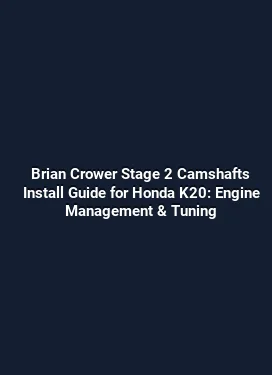The Top 5 Engine Platforms with the Best Tuning Headroom for 2025 Builds
Choosing the right engine platform is a foundational step for project cars aiming to maximize power, reliability, and measurable gains. Tuning headroom—the ability to push more power without sacrificing driveability or safety—depends on several interrelated factors: ECU flexibility, sensor suite, fuel delivery architecture, turbocharger or blower compatibility, and supporting ancillary systems. The following sections dissect five mainstream engine platforms that consistently deliver robust tuning headroom in 2025 builds, along with practical considerations, common tuning paths, and real-world implications for horsepower, torque, and drivability.
Overview: What Determines Tuning Headroom Across Engine Platforms

Headroom is not a single metric; it is the cumulative result of calibration latitude, hardware resilience, and data-backed decision-making. The core pillars include calibration flexibility (how easily fuel, ignition, boost, and timing can be adjusted), fueling architecture (direct injection vs. port injection, high- vs. low-pressure systems), and the ECU’s ability to manage complex sensors without stability penalties. Platforms vary in how they handle fueling strategies, knock control, heat management, and turbo or supercharger efficiency, all of which shape the practical ceiling for power while maintaining safe engine operation under track, race, or daily driving conditions.
In 2025, the availability of robust tuning ecosystems—encompassing software interfaces, dyno-proven baselines, and community-driven calibration libraries—has grown significantly. This ecosystem accelerates setup, reduces risk, and broadens access to advanced techniques such as flex-fuel strategies, remote tuning adjustments, and data-driven reliability enhancements. When evaluating headroom, it is prudent to assess not only peak horsepower but also how the platform performs across a full operating range, including spool behavior, throttle response, and transient stability under load.
Top 5 Engine Platforms for 2025 Builds
1. General Motors LS Family (Gen III/Gen IV)

The LS family remains a go-to for tuners seeking strong headroom with broad aftermarket support. The platform’s strength lies in a mature ecosystem: versatile fuel delivery options (multi-port and direct injection varieties), a well-supported aftermarket cylinder head and camshaft catalog, and a highly adaptable ECU suite that tolerates aggressive calibrations while preserving reliability. Practically, LS engines offer straightforward path to increasing power via bolt-ons (intake, exhaust, turbo or blower kits) and calibrated boost strategies, with generous headroom for both NA and forced-induction builds.
Key tuning levers include the ability to adjust fuel pressure regulation characteristics, torque management logic, and knock control thresholds. The platform’s robust low and high-pressure fuel systems enable aggressive fueling strategies at elevated boost levels, while heat management options—such as upgraded intercooling, radiator capacity, and oil cooling—help sustain power under sustained loads. For track-focused builds, paired components like forged pistons, improved rods, and optimized valve-train hardware are common upgrades that work harmoniously with ECU-tuned ignition timing to extract safe, repeatable power gains.
2. Ford Coyote 5.0 (Gen III and later)
The modern Coyote engine is renowned for its high-revving nature and tunable architecture. Its variable cam timing (VCT) control, sophisticated fuel and ignition mapping, and contemporary electronic throttle systems create a fertile ground for meaningful headroom. Tuning headroom on this platform often translates into improved torque delivery across torque bands, reduced throttle lag, and stable sustainment of higher boost levels when properly paired with a capable cooling strategy.
Practical gains come from a combination of enhanced intake and exhaust flow, intercooling efficiency, and calibrated boost management. For forced-induction builds, careful management of intake air temperature, fuel quality, and ignition timing is essential to prevent knock and ensure reproducible dyno results. An often overlooked factor is transaxle compatibility and drivetrain tuning, which protects power gains from being wasted by traction or gearing limitations. A balanced approach includes high-quality hardware upgrades (pistons, rods, studs) where applicable, along with a calibrated fuel and ignition map tuned for the specific turbocharger or supercharger kit in use.
3. Toyota 2JZ-GTE and Modern Turbocharged Variants
The 2JZ lineage remains iconic for its legendary headroom and robust tolerance to power increases. While older 2JZ models rely on mechanical durability and aftermarket support, modern variants and high-performance platforms continue to push power further with advanced ECUs and precise fueling strategies. The 2JZ-based builds benefit from abundant data, proven calibration scripts, and a large community that shares baseline maps and wear-resilient hardware configurations.
Key considerations include maintaining adequate fuel delivery capacity, ensuring injector compatibility for high-precision fuel control, and selecting a turbocharger kit that aligns with the engine’s thermal characteristics. A successful 2JZ build often leverages a multi-fuel approach, combining high-octane race fuel or E85-compatible strategies with careful knock control. This approach yields meaningful torque gains and smooth power delivery without compromising engine longevity, especially in long-duration or endurance-style sessions.
4. Nissan VR38DETT (GT-R and platforms with similar architectures)
The VR38DETT platform is a modern, tightly integrated powerplant that combines twin-turbo charging with advanced engine management strategies. Tuning headroom here comes from a well-designed ECU that handles sequential boost, precise fuel delivery, and complex timing maps. The platform responds well to comprehensive software calibration that optimizes turbo spool, intercooler efficiency, and throttle response while protecting the engine under high load.
Practical tuning focuses on optimizing air-fuel ratios across boost phases, smoothing out boost transitions, and refining knock control under elevated cylinder pressures. An important aspect is the intercooler configuration and charge air cooling efficiency, which directly affects the ability to sustain higher boost levels without heat soak. Reliability enhancements may include upgraded cooling loops, stronger connecting hardware, and well-matched intake and exhaust paths to maintain consistent performance in varied ambient conditions.
5. BMW S58 and Similar Modern Turbocharged Inline-Sixes
For enthusiasts seeking a modern, refined platform with strong tuning potential, the S58 and its contemporaries offer impressive headroom thanks to sophisticated turbo charging, precise electronic control, and flexible fueling strategies. The tuning sweet spot often lies in balancing turbo efficiency, intake-mrunner optimization, and the management of heat in a tightly packaged engine bay. The result is linear, controllable power delivery that remains responsive to throttle input, with room to push further for track or time-attack applications.
To maximize headroom on this platform, focus on robust cooling upgrades, high-quality intake plumbing, and a tuned calibration that respects the engine’s temperature envelope. Given the complexity of high-performance inline-sixes, collaboration with a tuner who has hands-on experience with the ECU ecosystem can significantly reduce trial-and-error time and emphasize safe, repeatable results across a wide operating range.
Practical Tuning Strategies for Maximizing Headroom
Regardless of platform, translating headroom into actual performance involves a structured approach that combines data-led decisions with mechanical enhancements. Start with a baseline assessment using a supervised dyno pull and data logging to understand torque curves, knock events, fuel trims, and air-fuel ratios across RPM bands. From there, the following strategies are commonly deployed:
- Boost Management and Spool Optimization: calibrate wastegate pressure or electronically controlled boost pathways to align with turbine efficiency and intercooler performance. A smooth spool curve reduces peak torque spikes that can destabilize traction and wear drivetrain components.
- Fuel Strategy and Octane Management: implement staged fueling or flex-fuel capability to maintain optimal air-fuel ratios as ambient conditions change. A robust fueling strategy pairs with reliable fuel pump and line pressure calculations to prevent volumetric efficiency losses at high demand.
- Ignition Timing and Knock Control: advance timing within safe margins to extract extra energy while monitoring cylinder pressure and knock sensors. A conservative approach in hot weather or high ignition energy setups helps preserve engine life.
- Heat Management: invest in intercooling, oil cooling, radiators, and thermal shielding. Consistent temperatures improve both power retention and engine longevity under repeated high-load conditions.
Notes on Semantics and Trend Considerations
In practice, modern tuning is deeply informed by data science and sensor-driven insight. Practitioners often rely on time-series analysis of air mass flow, manifold pressure, oxygen sensor readings, and knock events to guide calibration updates. These elements collectively contribute to a more accurate depiction of how a platform behaves under different operating modes, enabling predictable gains rather than arbitrary horsepower numbers.
Trend-related observations in 2025 point to increasing emphasis on hybrid-harvest strategies in tuning workflows, where data consistency across sessions yields better repeatability. Advanced logging, including high-resolution temperature, pressure, and vibration metrics, supports resilient calibration strategies. While the terminology evolves, the underlying discipline remains rooted in safe, measurable, and repeatable performance enhancements rather than guesswork.
Selecting the Right Platform for Your Build
Choosing among these platforms depends on project goals, availability of hardware, and the tuner’s experience with the specific ECU architecture. For street-driven cars, LS or Coyote platforms offer broad compatibility with a balance of daily usability and significant power potential. For track-focused explosions of power, platforms like VR38DETT and S58-based engines provide a pathway to high-end performance when paired with robust cooling, reliability-focused hardware, and careful calibration discipline. The decision should factor in drivetrain compatibility, suspension tuning, brake upgrades, and the intended operating envelope, from streetability to high-speed efficiency on a closed track.
Finally, the success of any 2025 build hinges on progressive, data-informed iterations. Start with a well-documented baseline, log comprehensively, and plan calibration milestones that align with real-world testing cycles. With the right platform, a clear roadmap, and a focus on endurance, a enthusiast can realize substantial gains without compromising long-term reliability.





